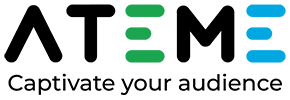The term datacasting with NEXTGEN TV has recently come to the fore. But what is it, what does it bring, and where can it be used?
Datacasting combines data and broadcast. And it’s all about increasing communication. It enables more efficient and effective transport of large amounts of data to a wider audience. In turn, this reduces congestion from natural and manufactured obstructions, meaning networks are cleaner and end users enjoy a higher Quality of Experience.
In terms of the broadcast aspect of ATSC 3.0, the key is getting data out as Internet Protocol (IP) packets. They may be audio or video files, firmware updates, and cached or live real-time files. In the end, it’s all data. But because there is an increase in quality, devices, and smart products, data consumption is soaring.
But how does this help you?
How it Works for You
As a broadcaster, you’re looking for balance: how to reach your viewers more efficiently and how to monetize your business. So obviously you have a host of questions when it comes to datacasting with NEXTGEN TV. How does it work in an area congested with obstacles such as mountains, buildings, etc.? What about the correlation between urban density and connectivity? How much data is being used in that particular area or market? Each market is different, and they all feature their own specific benefits as well as challenges.
ATSC 3.0 implemented new codecs for improved efficiency in the broadcast spectrum and creates an innovative opportunity for datacasting. This means that broadcasters can send the same TV channels over a much smaller bandwidth than with previous standards. In turn, this allows them extra bandwidth for other things including non-video content. For instance, it could be used for enhanced emergency alert messaging, educational services, software updates, or more. It also enables them to monetize that excess bandwidth, effectively leasing it for data distribution. Some broadcasters such as ARK Multicasting are making datacasting their primary business using the new standard.
“The interest that we are seeing from companies in the cloud, CDN, OTT, and ISP space tells us that there is a huge opportunity for broadcasters that choose to be ready for the soon-coming datacasting business.”
Joshua Weiss, Co-founder and CEO of ARK Multicasting
Why You Should Consider Using NEXTGEN TV for Data
The reason is simple. Have you ever tried to stream a video online to have it buffer several times, or download a software update and have it take much longer than it really should? How many others are doing the same thing at the same time? Traditionally, every other person doing this at this moment has a direct connection to the same source as you.
What if everyone could be sent the same data at the same time, with only one copy sent via the same network? This is where broadcast technology comes in. It provides a single source to multiple destinations, a multicast connection. The Broadcast Internet.
In major cities, it helps reduce congestion on the network, and in rural areas it expands the reach where poor connectivity exists, while preserving precious bandwidth. ATSC 3.0 also adds single frequency networks (SFNs) where multiple transmitters can broadcast the same data over an area. This helps solve the problems in areas previously constricted by buildings or geography.
The Benefits of Datacasting with NEXTGEN TV are Limitless
We’re already seeing the benefits of data transmissions over the ATSC 3.0 spectrum. These capabilities give you the power to connect people, information, and services, for example:
- Emergency alerts: This has been a part of the ATSC standard for many years. But as more data becomes available and the standard becomes more efficient, this can only be used more effectively.
- Automotive companies: ATSC 3.0 reception capabilities are being added to new cars. So, when auto companies need to send out software updates, datacasting allows this to happen.
- Distance learning: This has become a major topic, especially over the last few years during Covid. Using the ATSC network to help in low-income areas where Internet may be limited, students can study their lessons at home.
- Transportation: Businesses that require small data distribution can use this network to send one message to many end points.
Datacasting with NEXTGEN TV — merging over-the-air broadcasting with the Internet — is a recent market. And there are major opportunities. However, it will take time to get everyone on board and additional time to reap the benefits. But in saying that, the buzz is out there, contracts are being signed, and the potential for growth is encouraging.
“Broadcasters that make the leap will be rewarded with the flexibility of new revenues from multiple streams. Those that wait will most certainly be at a disadvantage.”
Joshua Weiss, Co-founder and CEO of ARK Multicasting
If you’d like to talk more about NEXTGEN TV and how Ateme can help, drop me a line or meet us at NAB Show at Booth W1517.

